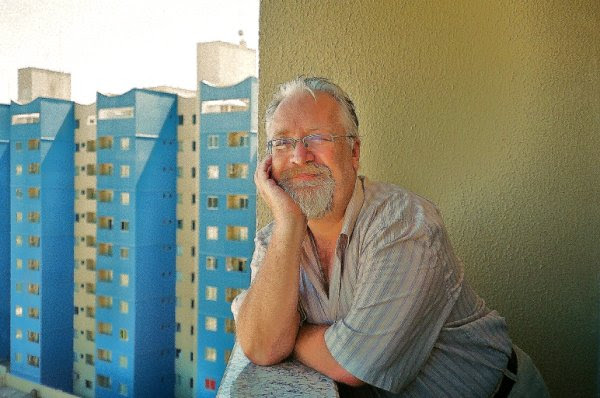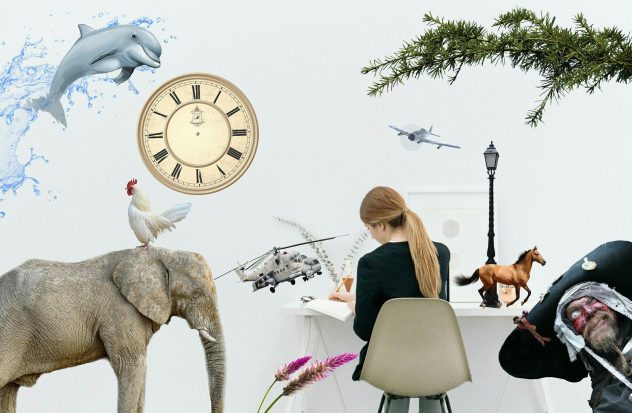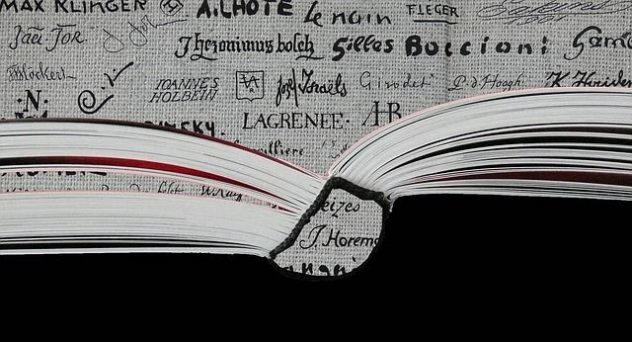 By David Futter (Retired IE Teacher, MED in IE alumni)
By David Futter (Retired IE Teacher, MED in IE alumni)
On a lazy Sunday afternoon in my local coffee shop, I was reading Thomas King’s book, The Truth about Stories, in which he observed, “The truth about stories is, that’s all we are.” Contemplate this thought, the phrase, “My God, it’s full of stars!” popped into my head. It is fictional astronaut Dave Bowman’s comment, uttered as he entered the Sentinel, a huge, black rectangular prism floating above Jupiter in Arthur C. Clarke’s novel 2001: A Space Odyssey. Now in full daydream mode, I reimagined the scene as standing beside William Shakespeare’s deathbed, seeing him in his final moments surveying the feats of his life and observing in a concluding gasp, “My God, it’s full of stories!” How easy it is for the imagination to feed the storyteller in us. It is my contention that story, along with imagination and emotion, are formative aspects of the human condition.
Tell Me a Story
We are, as Jonathon Gottschall (2013) titled his book, storytelling animals. It is a seminal feature of human life. It’s an evolutionary development we have elevated to primary importance within the human condition. At some time in our cultural development, the use of language expanded from a purely pragmatic function to include ‘the story’. Imagine our ancestors sitting around the fire, telling stories to comprehend phenomena, explain the past, transmit beliefs and instill values. The stories helped build social cohesion.
Human beings are, as far as we know, the only animals to create stories as an evolutionary development. As Novak (1975) states, we see, “a present arising out of the past, heading into a future” and perceive “reality in narrative form” (pp. 175-176). Joined with the notion that humans are “perfinkers”—David Kresch’s observation that humans perceive, feeland think at the same time—story becomes a pivotal process for making meaning. Stories and the story format are “the great factories of meaning” (Gabriel, 2000, p. 4). As Kieran Egan and Gillian Judson (2016) explain, the story’s “great power lies in its ability to fix affective responses to the messages it contains and to bind what is to be remembered in emotional associations” (p.12).
In every human endeavour we find ‘story’ at play. We live by and with stories. Even while we sleep, our brain continues creating stories in the form of dreams. Stories provide the vehicle to make meaning and sense of the world around us. We create life-stories about ourselves that are often an interpretation of the reality we have experienced. Our stories are filled with the values, beliefs and ideas of the culture they inhabit. Story effects culture and culture, story. Good stories and lasting stories require imagination and emotion to be effective. Even the continuum of small white lies to large-scale fascist propaganda is a set of stories that evoke our emotions and provide us meaning in the world.
The Meaning of Story For Education
Naturally, the curriculum is a compilation of human knowledge and not all if it is fiction. Using stories in education does not mean only using or creating fictions. ‘Story’ refers more to how information is organized. When news anchors and editors refer to getting the ‘story’ on the latest community event, they expect the information/knowledge to be presented in a manner that viewers or readers will comprehend. Using the 5 W’s (Who, What, When, Where, Why) are mainstays in non-fiction and fictional stories. So, the unique way stories organize information is that they bring out the emotional force of a topic. They connect with the affective dimension of humans. Our emotions are the most powerful tools for sustaining and assisting in the recall of knowledge (Bartlett, 1932).
 Story is a cognitive tool that has the ability to bring the wonder in all things to life in the most vivid way for our students. Story generates and sustains meaning. It is for this reason that educators need to pay more attention to this aspect of social life. We can integrate this ability into our teaching, replicating “…the great success oral cultures achieved in story-shaping facts and events to engage imagination and build meaning” (Egan & Judson, 2016, p. 12).
Story is a cognitive tool that has the ability to bring the wonder in all things to life in the most vivid way for our students. Story generates and sustains meaning. It is for this reason that educators need to pay more attention to this aspect of social life. We can integrate this ability into our teaching, replicating “…the great success oral cultures achieved in story-shaping facts and events to engage imagination and build meaning” (Egan & Judson, 2016, p. 12).
As all knowledge is human knowledge, is it not imperative to use those human aspects we have developed through our cultural evolution to give them life to our students? I believe it is.
This rambling narrative is an attempt to put the cognitive tool of story to the front of the pack in education. I believe Kieran Egan’s theory of Imaginative Education brings a vision of how we can tap into the power of the story and, thus, can utilize people’s natural inclination to learning. What makes stories endure in memory is the affective attachment we connect to it. If we can feel what we read, then surely it is important to have students feel what we teach. In using the story-form in teaching, we shape topics in emotionally charged ways. Emotion helps affix the ideas in our mind.
Teachers can incorporate those dimensions of story and storytelling acquired from orality and literacy by employing cognitive tools in their practice. Through the use of cognitive tools we make sense of the world: we extend understanding. Most importantly, we will cultivate our students’ imagination—the ability to think of what is possible.
Also by David Futter: The Lure Of Imaginative Education
References
Bartlett, F.C. (1932) Remembering: A study in experimental and social psychology. Cambridge, UK: Cambridge University Press
Clarke, Arthur C. (1968) 2001: A space odyssey. UK: Signet
Egan, K., & Judson, G. (2016). Imagination and the engaged learner: Cognitive tools for the classroom. New York, NY: Teachers College Press.
Gabriel, Y. (2000). Storytelling in organizations: Facts, fictions, and fantasies. Oxford: Oxford University Press.
Gottschall, J. (2013). The storytelling animal: How stories make us human. Boston: Mariner Books.
King, T. (2011). The Truth About Stories: A Native Narrative. New York: House of Anansi Press.
Novak, M. 1975. ‘Story’ and ‘Experience’. In J. B. Wiggins (Ed.), Religion as story. New York: Harper and Row



Thank you David
What an inspiring read I found myself nodding with agreement and excitement as I read on.
Your commentary supports many ideas that i think are important for all educators. It is through story and narrative that learners make connections to their and others world. What a way to start the week reading such a perceptive article. Thank you Gillian for hosting this web site
Have a great day
Thank you Ian for your support!
Thanks Ian. It was a series of events that lead to me to see narrative and story as more important than i had before.
How cool is this? I’m reading Ready Player One to my kids after dinner (about 30–45 minutes / night…as a child of the 80s and a D&D player and someone who taught himself to program in Basic computer language, I’m finding so much of my childhood in this book!) and I come upon the end of Chapter 10. At the end, Wade/Parzival opens the first gate which reveals a portal…a field of stars and galaxies and a voice intones, “My God! It’s full of Stars!” and I’m like…Whoa! I just heard that/read that on Imagine Ed!
Thank you, David, for this chance to make the kinds of connections that drew me to my life as an English teacher. Your post’s focus on the importance of story hits home with me in another way: My 10th grade Gifted Honors English students are asked to read (just a straight reading for pleasure/comprehension) a novel over the summer–Salman Rushdie’s Haroun and the Sea of Stories. When they return to school, we read the novel again, but this time with a more critical lens. We read it through a Question Focus (see “The Right Question Institute” and the book, “Make Just One Change”) of “fictional stories are morally good lies.” We develop probing questions around this focus and then dig into the story, checking up on our questions along the way as we also look at the story as allegory, a Hero’s Journey, Satire, and, most important, as a story about storytelling and the importance of stories. Our “meta” journey through this book is always nothing but amazingly eye-opening to students, and it sets our classes on a year-long journey as we reflect constantly back upon the act of storytelling, fiction itself, etc.
But before we even start, we watch a TED talk that Jonathan Gottshall gave on his book’s premise. And we also take a look at some other aspects of story, such as the video series “Everything is a Remix.” David, your list of other books above will help me dive even deeper into this sea of stories and bring even more meaning to the act of reading, storytelling, and learning. Thank you.
If you’re interested, I have a series of videos in which I speak about our work through this novel and some of the interesting things the students discover along the way:
1) https://youtu.be/t-btbb6F_D4
2) https://youtu.be/Rx3PPrP7DTk
3) https://youtu.be/FAwS7ghdFrg (pick up at around 4:20 to hear the last bit about Haroun and the Sea of Stories)
Hi Garreth
Love hearing from you and learning more about what you do.
I’ve told David about your comment so hopefully he will reply soon. I want to thank you for this response and the links you include–I will definitely be checking those out. I can imagine you were motivated after stumbling upon the same line of text that inspired David’s imagination!
You have to write for imaginED!
That is really cool. I will check out the videos!
Hi Garreth. There is an episode of Star Talk with Neil deGrasse Tyson you might try to see. He has Gottschall and a researcher in Literary Cognition on and had a big influence on my thinking. This article is interesting as well: http://www.openculture.com/2015/07/this-is-your-brain-on-jane-austen-the-neuroscience-of-reading-great-literature.html
Thanks so much, David. I’ll definitely check out that episode of Star Talk and the article as well.
Sincerely,
Garreth.
Thanks I will check them out.
I need to ammend a comment about human beings as the only creatures who use story. It is not proven yet, but whales may have a similar capacity. Whales such as the Sperm Whale have brains 6 times as large as ours. Their neocortex is not only larger but but contains far more of the structures that enable planning for the future, abstractions and most importantly, language. The composition of clicks used by the Sperm Whale is 60 times more complex than our own language. So who knows?